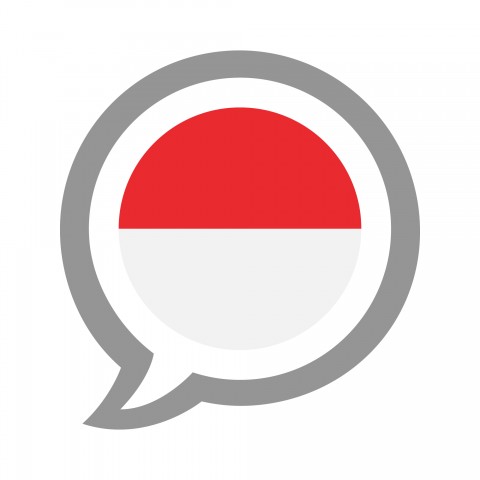
Many aspiring learners wonder whether the Indonesian language is easy to learn, and if so, why more people don’t speak it.
You see, Indonesian is not a very commonly learned language for most of the world.
Sure, there are people in Southeast Asia that pick some of it up, it’s a growing subject in Chinese and Japanese universities, and it’s long been one of the most popular foreign languages for Australians—but you hardly see it on lists of languages people want to learn.
That’s a shame, really, because learning the language opens you up to so many wonderful things. Visiting the country when you can speak the language is much, much more freeing than being limited to an interpreter or dealing with whoever can speak some English.
You might be interested in opening those doors, but maybe you’ve been put off by long words and a spooky reputation for being a difficult Asian language. Could there be truth in that?
 Table of Contents
Table of Contents
- Is Indonesian Hard or Not?
- Difficulties in Learning Indonesian
- Indonesian is Pretty Easy
- Your First Indonesian Steps
- Advice to a New Learner
- The Advantages of IndonesianPod101
- Conclusion
1. Is Indonesian Hard or Not?

Indonesian, by and large, is not that hard of a language. From the perspective of someone who’s already learned it, that might not be too reassuring, but it’s the truth.
There are quite a few differences between European languages and East Asian languages. But the thing is, none of these differences are the type of thing that requires you to memorize long charts or pore over difficult grammar explanations.
For example, Indonesian has a number of suffixes and prefixes that can change a root word’s part of speech. That’s one place where learners might get confused, because sometimes, those can be pretty subtle. It takes a lot of immersion to develop the knack for knowing which one to use.
But on the other hand, there are so many shortcuts that you can take. Indonesian is the second language of millions of people across the country, spoken with great fluency but without extremely rigid rules for conversation.
Locals are also extremely welcoming to foreigners who can converse in Indonesian—even if they’re comfortable in English, they’ll happily speak Indonesian instead to let people practice!
2. Difficulties in Learning Indonesian

There are a couple of factors that can make Indonesian hard to learn for some people.
Indonesian is a bit of an artificial standard, as mentioned above, so people add a lot of slang and regionalisms to it when speaking among themselves. That’s why you might find YouTube videos super-easy to understand, but the more informal speech of day-to-day conversation nearly opaque to your ear.
That kind of diglossia can be disheartening, because you’ll feel that you still have so far to go even if you can understand books and the news.
The best way to deal with this is to read more informal Indonesian, such as YouTube, Facebook, and Twitter comments. Internet comments have a bad rap for being mindless drivel, but unfortunately, it’s exactly that kind of language register that you have to learn to understand—because it’s the way people really speak!
On the other side of things, the prefix and suffix system definitely has its sticky points. One of the hardest concepts for people to grasp is the me-kan prefix/suffix, which is often used to signify that something was done “for somebody.”
- Saya membaca koran Kompas.
“I read the Kompas newspaper.”
- Saya membacakan ayah berita hari ini.
“I read today’s news to my dad.”
The root is baca (“read”) in both sentences. But while membaca is an act of reading for oneself, using the circumfix me-kan causes the word to mean that the act of reading is done for someone else.
Not too bad, right? Unfortunately, that’s just one example for a circumfix with a ton of different meanings! You’re probably going to have to learn a ton of examples individually.
The last thing that trips up learners is the idea that it’s okay to be vague. A lot of people never get past the idea that they want to express exactly as much information in Indonesian as they’re used to expressing in their native language.
3. Indonesian is Pretty Easy

You might have picked up on this already, but that last section isn’t that big of a deal. Overall, Indonesian is easy to learn as a foreigner.
For one thing, you can just learn these complicated prefix or suffix words as individual concepts that usually map to their own separate words in English. In the example above, there’s nothing wrong with learning membaca as “to read” and membacakan as “to read for.”
Another advantage that Indonesian-learners have is that the pronunciation is quite easy in general. While you do have to know how to roll your R and use pure vowels (for more help, check our pronunciation guide), spoken Indonesian words correspond exactly to their written counterparts.
Even when people speak informally using the more casual variants of Indonesian, they reflect that in their casual writing. In English, we all write “have to” even though we say “hafta,” but in Indonesian texting and online comments, there’s no worrying about proper writing conventions.
Lastly, learners of Indonesian have a huge advantage when it comes to the verbs. Each “tense” corresponds to a single particle that’s inserted before the verb—no conjugation required.
For past events, use sudah; for present progressive, use sedang; and for future, use akan.
- Saya sudah membeli buku.
“I bought a book.”
- Saya sedang membeli buku.
“I am buying a book.”
- Saya akan membeli buku.
“I will buy a book.”
4. Your First Indonesian Steps

The very first thing you should do when learning Indonesian, or any new language, is to focus on the sounds.
Make sure that you can accurately make and understand each individual sound of the language now, because later on when you’re trying to understand flowing native speech, you’ll wish you had prepared beforehand.
It would be perfect if you could find a video series with clearly spoken Indonesian and Indonesian subtitles for you to understand how the letters you see on the screen reflect the sounds you’re hearing. Even though the Indonesian alphabet is simple, this is a skill that takes time to develop.
After that, your biggest hurdle is going to be the vocabulary. Although Indonesian has some loanwords from European languages (particularly when it comes to the sciences or pop culture), the vast majority of the words come from Arabic, Sanskrit, and local Austronesian languages.
Therefore, you’ll need to come up with a good flashcard or wordlist system in order to build a strong vocabulary base from the start.
- → Check out our vocabulary list on Simple Strategies for Learning Comfortably at Home!
5. Advice to a New Learner

One of the biggest mistakes a new Indonesian learner can make is trying to speak too quickly. By that, we don’t mean the speed that the words are coming out of your mouth; we mean how soon you start speaking after you’ve started learning the language.
Just like pronunciation, you should build a good base in understanding Indonesian before you try to hold a conversation. That way, you won’t be distressed by not understanding what you hear.
Also, don’t worry if it takes you much longer to understand TV or movies than it does to read your textbook or listen to a course made for learners.
As mentioned before, rapid-fire spoken Indonesian uses a lot of local slang terms. Even the words for “you” and “I” are different in informal language! Generally, the words are Anda and saya respectively, but in informal Indonesian, they’re kamu and aku—and in Jakartan slang, they become lu and gue!
Essentially, even though you’ll find Indonesian easier to pick up than some other languages, don’t expect to be able to use and understand it instantly. Keep your expectations reasonable, and you won’t be discouraged.
- → Study our vocab list of the Top 10 Inspirational Quotes if you need a language-learning pick-me-up!
6. The Advantages of IndonesianPod101
Remember a bit ago when we recommended videos with Indonesian subtitles?
It turns out that you can get exactly that for free on our IndonesianPod101 YouTube channel.
Once you’ve watched a couple of those, why not check out our main website at IndonesianPod101.com?
Although there are good textbooks and online resources available if you know where to look, Indonesian isn’t commonly learned enough to have a ton of different language courses.
What IndonesianPod101 can bring you is a structured course starting from the very basics, guiding you all the way through an upper-intermediate or advanced level. At that point, you’ll be able to smoothly transition into reading and watching real Indonesian content made for native speakers!
7. Conclusion
When it comes down to it, the only big obstacle to learning Indonesian, or any other language, is time.
Indonesian requires a little more time for you to remember the wide array of vocabulary, but practically no time at all to learn the grammar.
In fact, the United States government rates Indonesian a 3/5 in terms of difficulty for English-speakers. That means it’ll take a little more time than learning French or German, but significantly less time than learning Arabic or Korean.
As long as you have a good and consistent study schedule, you’ll be able to hold your own in simple Indonesian conversations in less than six months. After you learn the basic sentence patterns, all you need is a good dictionary to build your vocabulary and gain the ability to understand more and more real Indonesian.
The best time to start is today. Grab a textbook—or better yet, sign up with IndonesianPod101—and you’ll be amazed at the kind of progress you can make with Indonesian.
If you’ve already started learning Indonesian, which aspects of the language are most difficult for you? And which are the easiest? Let us, and aspiring Indonesian-learners, know in the comments!










